Bovine Lameness and Podiatry
Digital Dermatitis
G Cramer
What is it
An infectious and contagious bacterial infection of the skin, commonly seen in the cleft of the foot at the coronary band level. This means it is visible in the standing animal and is usually centered on the front or rear of the foot.
Also called hairy heel warts and strawberry heel.
How to recognize it
Digital dermatitis presents in a variety of stages ranging from painful, bright red and ulcerated, or a less painful, grey/black, circular, granulomatous skin lesion. Edges can have a white margin and/or “hairs” protruding from them.
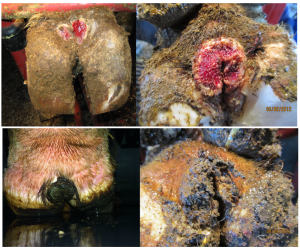
Lesions are clearly demarcated and are typically located in the interdigital cleft, but can occur on other locations such as the interdigital space or at the front of the foot.
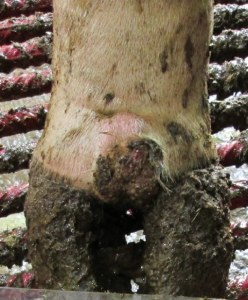
Severe lesions can become proliferative with filamentous projections or hyperkeratotic (image below).

It is useful to classify lesions into “active” (painful and ulcerative lesions > 2 cm) and “chronic” (grey/black hyperkeratotic lesions without painful ulcerative lesions >2 cm). In the image below, the active lesion is on the left, chronic lesion on right.
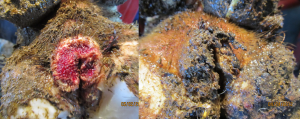
Pathogenesis
Mechanical irritation of the skin and maceration by water and chemicals from manure weakens the skin barrier.
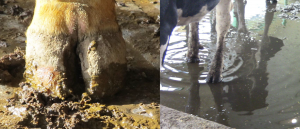
A synergistic group of bacteria including Treponema spp then invade and infect the weakened skin barrier, leading to acute inflammation of the dermis and epidermis.
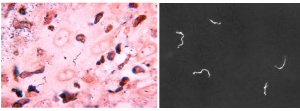
These bacteria are common in the environment and normally live in the rumen. There do appear to be some more virulent strains on some farms and more susceptible cattle as not all farms are infected with DD and some cattle are infected repeatedly. Treponema species are gram negative spirochetes that are microaerophilic and can encyst for environmental survival. As the bacteria invade the epidermis and damage the different layers, the body responds with a local inflammatory process that can result in the hyperkeratosis and proliferative lesions.

Risk factors on Dutch dairy farms included standing manure (fewer scrapings), larger farms and older cows. Factors that helped included rubber flooring in the passageways and using footbaths with an alternative active compound to formalin or formalin + copper sulphate.
How to prevent it
Risk factors most commonly include lack of access to pasture, cattle housed in smaller cubicles, dirty or moist environments, and slippery floors. More rapid increases in concentrate supplementation after calving has been linked to increased infections. Larger herds, animal mixing practices, and animal factors (parity, breed, lactation stage) can increase the risk. Digital dermatitis can enter the herd through new animals and fomites such as hoof trimming equipment.
The main focus of prevention is hygiene. Providing a clean environment without wet or abrasive walking surfaces decreases the chances of bacteria invading a weakened skin barrier.
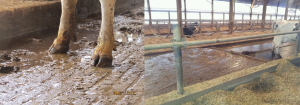
Footbaths are a preventative measure that should be used at whatever frequency is necessary to minimize the occurrence of active painful lesions. Footbaths need to be at least 10 feet (3m long) and are typically filled with disinfection solutions such as copper sulfate or formalin. The length ensures at least two immersions per rear foot.
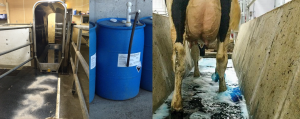
Other preventative measures include preventing infected animals from entering the herd and ensuring replacement animals are managed to prevent new infections.
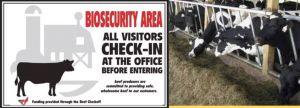
More recently, this condition is being seen in higher numbers in dry feedlots. We don’t know why.
How to treat it
Currently, very few licensed products exist to treat DD. Lightly clean the foot to remove manure; avoid causing additional bleeding. Treatment typically consists of applying topical tetracycline based antibiotics to active lesions using a wrap or a paste. Generally use 1/2 tsp of tetracycline powder mixed in 6 ml glycol; apply to the lesion with a paintbrush. Wraps are not necessary but if they are used they should be removed within 24 hours. Lameness should gradually improve over the next week.

Non-antibiotic compounds typically containing heavy metals such as copper are also often used in the field. The role of topical treatment is to treat active lesions and hasten its transition to a chronic lesion. Once the lesion is chronic, footbaths are used to prevent recurrence.
Systemic antibiotics do not penetrate into the lesion. Topical antibiotics seem to work quickly and effectively.
Key Takeaways
Digital dermatitis is due to Treponema infection of wet, traumatized feet. It leads to lameness and foot erosions or growths. Topical tetracycline is used to treat it.
Footbaths are useful to prevent bacterial infections – foot rot and digital dermatitis.
Resources
Lameness originating in the hoof of cattle, Cramer and Solano, merckvetmanual.com
Implications for lameness control in cattle -Vet Clin Food Anim 41 (2025) 395–406
Evaluation of selected risk factors for different stages of digital dermatitis in Dutch dairy cows. The Veterinary Journal, Vol 304, April 2024, 106086
The Dairyland Initiative -good pics!
Treating and bandaging a foot -video

